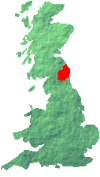

Welcome to my page...a world in progress
Where is Northumberland?

Here's a map of the Districts and Towns in Northumberland
Northumberland resides on the north east coast of England. The English County of Northumberland is divided into 6 Districts and the main towns and villages
Northumberland of the County are grouped below into these six areas. Alnwick District,
Berwick-Upon-Tweed Borough including Holy Island Tide Crossing Timetable, Blyth Valley, Castle Morpeth, Tynedale District, Wansbeck District .
No other region of England has as many castles and fortresses as
Northumbria - a testimony to the region's strategic position during
turbulent times past. Ever-wary of invaders from the sea and raiders
from Scotland, the Border landowners built large and lasting strongholds.
The magnificent castles of Alnwick, Bamburgh, Chillingham,
Dunstanburgh, Durham, Lindisfarne, Lumley and Raby are all potent
examples of past battles and glories. Now, these magnificent buildings
still stand proud - but as museums, stately homes, impressive ruins ...
and even hotels! Several are still privately owned and lived in.
A glance at the history of just a few of them tells the wild and bloody
story of Northumbria....
Most of the biggest towns - Blyth, Ashington, Cramlington, Morpeth and
are in this urban corner. The large rural area is served by three main market
towns, Alnwick, Berwick-upon-Tweed, and Hexham whilst Prudhoe is the population
centre for East Tynedale, on the edge of the Tyneside connurbation. Within
the rural area there are more than 200 villages with fewer than 500 residents.
Northumberland is one of the four main areas of North East England (or Northumbria)
the others being Tyne & Wear, County Durham and the Tees Valley (formerly known
as Cleveland).
The City of Newcastle upon Tyne, in Tyne & Wear, was once the county town of
Northumberland and is still regarded by many Northumbrian's as their main centre
for shopping, universities and nightlife. The county's other neighbouring areas
are North Tyneside (including Whitley Bay) which was part of Northumberland as
recently as 1974; County Durham, a similar predominantly rural county with Durham
City at its heart; Cumbria, England's Lake District; and the Scottish Borders, now
our close friends rather than our deadly rivals. The Scottish capital of Edinburgh
is a mere 46 miles from Berwick-upon-Tweed.
The Wild Border Reivers
For 300 years, the English and Scots fought bitterly for control of the
borderlands. For example, Berwick upon Tweed changed hands thirteen
times before becoming English (in all but footballing terms!) in 1482.
Throughout Northumberland, a great chain of castles and fortified
manor houses still stands as testament to this fierce dispute -
Warkworth, Chillingham, Callaly, Cresswell, and Etal castles, along with
the historic battlefields of Otterburn and Flodden. The modern path of
the Reivers is much more peaceful - the Reivers Cycle Route crosses
some of the most charming areas of Northumberland on its way to
Cumbria.
Raiders from the Sea
The region's coastal fortresses were often built in response to the threat
of seaborne invasion. A stunning example of this is Tynemouth Castle
and Priory, perched bravely on the clifftops at the mouth of the River
Tyne. But perhaps the most impressive of them all is Bamburgh,
standing high above the beach, but nonetheless stormed three times by
the Norsemen.
Palaces of the Prince Bishops
Elsewhere in the region, you can see mighty castles that are the legacy
of Durham's Prince Bishops. Durham and Norham Castles, and the
Bishop's Palace at Bishop Auckland were all once well-defended
ecclesiastical palaces, from the days when Bishops ruled the North like
kings. Durham Castle became the home of England's third oldest
University in 1832, and is now a student residence which accommodates
visitors during vacations.
Mighty Barons
Powerful families also once ruled Northumbria, building impressive
fortified homes. Barnard Castle in the south of the region was a
Norman stronghold; Raby Castle was the home of the Nevill family,
who governed large tracts of County Durham for centuries;
Dunstanburgh was the property of the Duke of Lancaster; and Alnwick
Castle has always been the home of the Percys, Dukes of
Northumberland. *
*Information provided by the from Northumbria Tourist Board
The Sites of Northumberland
My Favourite Landmarks
Alnwick Castle
Bamburgh Castle
The bridge at Alnwick Castle
The graves of 3 Thirteenth Century Knights
Cannons at Bamburgh Castle
The North Sea from a Bamburgh Battlement
The spire inside Warkworth Castle
A tower inside Warkworth Castle
Dunstanburgh Castle
Lindisfarne Castle
Holy Island Castle
Woodhorn Colliery in Ashington
Woodhorn Colliery in Ashington
The Bothel Priory
Looking down Hadrian's Wall
Inside a garrison at Hadrian's Wall
Hadrian's Wall
Grace Darling's resting place
Berwick Upon Tweed
My Favourite Football Team

My Favourite NHL Team






